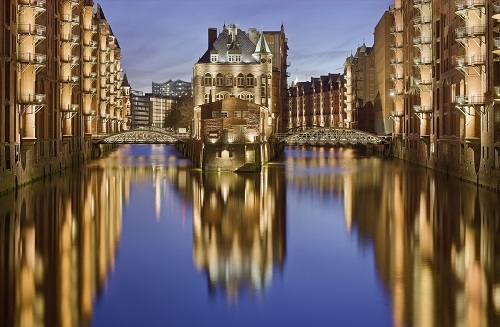Hamburg

The ARCH project in Hamburg focuses on the World Heritage site and the updating and refining of the management plan and monitoring system of the Speicherstadt and Kontorhaus District. The focus will be in particular on present and potential damages caused by natural hazards, like flooding, heavy rain events and changes in the tidal differentials. To this end, the project will establish a baseline of historical records and in a second step monitoring tools to be able, at the end of the project do previsualisations of scenarios. The Speicherstadt and Kontorhaus District with Chilehaus was added to the UNESCO World Heritage list on 5 July 2015.
The World Heritage Committee based its decision on the belief that the Speicherstadt and the Kontorhaus District are "an outstanding example" of buildings and an ensemble which "illustrate significant stages in the history of humanity". The Outstanding Universal Value of the two mono-functional but complementary areas is reflected in Hamburg’s historic warehouse district with its connecting network of roads, canals and bridges dating from 1885 to 1927 and in the modern red-brick architecture of the office building ensembles for port-related use from the 1920s to 1950s.
Hamburg was and still is a dynamic port and trade centre that is in a constant state of flux. At the end of the 19th century, a transformation process had been initiated with the construction of the Speicherstadt resulting in Hamburg transitioning from a city with mixed living, commercial and working quarters to a modern city with service districts. This construction of the Kontorhaus district was just one example that continued this process at the start of the 20th century. The result is the Speicherstadt and bordering Kontorhaus district, two densely built-up central city quarters in the German port city of Hamburg.
The Speicherstadt in Hamburg
The Speicherstadt was originally constructed between 1885 and 1927 by the "Hamburger Freihafen-Lagerhaus-Gesellschaft" (HFLG) shipping company on a 1.1 km long archipelago in the Elbe river (reconstructed in part between 1949 and 1967). Constructed in three building phases, the Speicherstadt remains the largest cohesive and integrated ensemble of warehouses in the world to this day. Using new technology and materials, it is a unique representation of the attractive but functional maritime industrial architecture of historicism with a European flavour. As a result, the Speicherstadt is of high international importance thanks to its architectural history. With its composition of red brick buildings in neo-Gothic architectural forms, its streets, waterways and bridges that create that unmistakeable image of a "city of warehouses". Today, this area of Hamburg is a formative part of the entire cityscape.
This "city of warehouses" includes 15 large warehouse blocks with an original historical appearance but very progressive in terms of their technical facilities and equipment, as well as six decorative ancillary buildings and a network of roads, canals and bridges.
Kontorhaus District
The adjacent Kontorhaus district is a cohesive, densely built area featuring very large office complexes that were built from the 1920s to the 1950s to house businesses engaged in port-related activities. Together, these neighbouring districts represent an outstanding example of a combined warehouse-office district associated with a port city.
Anchored by the iconic Chilehaus, the Kontorhaus district's massive office buildings stand out for their early Modernist brick-clad architecture and their unity of function.
The Chilehaus, Messberghof, Sprinkenhof, Mohlenhof, Montanhof, former Post Office Building at Niedernstrasse 10, Kontorhaus Burchardstrasse 19-21 and Miramar-Haus attest to architectural and city-planning concepts that were emerging in the early 20th century.
Yet, in contrast to office block architecture of the 1920s and 1930s elsewhere in the world, which was characterised by the Beaux-Arts style or other historicised forms, the office block buildings in Hamburg’s Kontorhaus district already displayed modern clinker façades in expressionist and the new objectivity architectural forms which, particularly in the Chilehaus and the Sprinkenhof, achieved an almost unsurpassable degree of virtuosity in terms of design and craftsmanship. Furthermore, the Chilehaus by Fritz Höger is regarded as an icon of architectural expressionism with its tip reminiscent of a ship's bow and characteristic detailing of its façades.
Hamburg flyer
English (download)
German (download)









